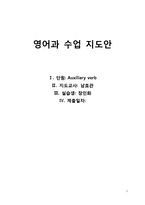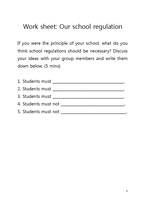Ⅰ. Master plan
ⅰ. Topic
ⅱ. Overall learning objectives
ⅲ. Teaching Aids
Ⅱ. Lesson plan
ⅰ. Teaching procedure
Ⅲ. Appendix
ⅰ. Power point script
ⅱ. Work sheet
Presenting the objectives Review
- Before we start this class, I want you to tell me what we learned from last class.
What have we learned about auxiliary verbs last time?
* Activating students’ schemata by showing the parts of our school regulations translated into English.
- As you know, we should keep these regulations.
* Presenting specific objectives of the lesson
In this time, we are going to make our ‘school regulation’ which includes what you think students should keep if you were a principle of high school.
- To read one’s school regulation list.
- To write their own regulation list.
- To discuss what students should keep in school as high school students.
- To present their school regulation list. Power Point
5
Obtaining the grammar background * Asking comprehension questions about the grammar
- Our school regulation list (ppt)
What do you think they have in common? Yes, that’s right! (Bolded on ppt)
They have this form called ‘auxiliary verb, must’. By using this form, we are going to do an exciting activity! Making our own school regulation list!!
Before we start, I think we should learn this form more to actually use it by your own, right?
Explaining the grammar rules before actual use
1) must must not
= have to =should
You use must to indicate that you think it is
very important or necessary for something
to happen, usually because of a rule or law.
You use must not or mustn’t to indicate that
you think it is very important or necessary for
something not to happen.
Past form: had to / future form: will have to
2. must cannot.
Past form: must have pp
You use must, or must have with a past
particle, to indicate that you believe that
something is the case, because of the available
evidence.
Power point 15











 분야
분야


